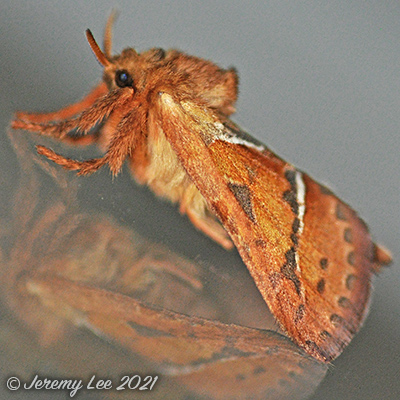
 |
|
Scientific Classifications explained » Amphibians » Ants » Aphids » Bees » Beetles » Birds » Bugs » Butterflies » Caterpillars » Damselflies » Dragonflies » Earwigs » Flies » Frog/Leafhoppers » Fungi » Galls » Grasshoppers » Harvestmen » Hoverflies » Lacewings » Ladybirds » Leaf Mines » Lichens » Mammals » Millipedes » Mosses » Moths » Sawflies » Slugs » Snails » Spiders » Trees & Shrubs » Wasps » Wild Flowers » Woodlice » Postboxes |
UK Nature > Moths > Triodia sylvina

Scientific Name: Triodia sylvina Common Name: Orange Swift Triodia sylvina, more commonly known as the Orange Swift, is a species of moth belonging to the family Hepialidae. It was previously placed in the genus Hepialus. This species has a wingspan of 32 - 48 mm. The male has rich orange forewings with two white bars forming a "V" shape. The hindwings are dark brown. The female is similar but generally larger and less brightly coloured. It flies at night from June to September and is attracted to light. The larva feeds on the roots of various plants including bracken, dandelion, dock, hop and Viper's Bugloss. The Orange Swift is short-lived as its shortened proboscis prevents it from being able to feed. It over-winters twice in its larval form and pupates below ground. In the UK and Ireland this resident moth is found throughout, but is more common in lowland habitats. |
|

https://www.uknature.co.uk is a website dedicated to showing the immense diversity of UK nature and wildlife. Our vast range of habitats, from lowland arable to snow covered mountains, from storm-ravaged coastlines to peaceful inland freshwater lakes and rivers, from dry, sandy heaths to deciduous and coniferous forests, all these habitats contribute to the abundance of UK nature. We have wild birds in huge numbers either residing or visiting our shores (597 recorded species as at July 2013) and we must also not forget the humble back garden with its grass lawns, flower beds filled with nectar rich flowers, shrubs and trees, all designed to attract huge numbers of insects such as bees, moths, butterflies and hoverflies; and finally the small ponds which provide safe havens for frogs, toads, newts and even slow worms and grass snakes. www.uknature.co.uk is the showcase for my personal passion, photographing uknature in all its glory. I sincerely hope you all enjoy the fruits of my labours. This site and all images contained therein is © Jeremy Lee 2004 - 2025. All Rights Reserved. Site design by Jeremy Lee. Site development & IT Support by Stuart Lee. |